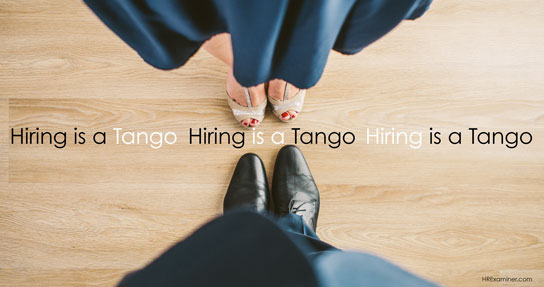In hiring, you are always locked in competition with other employers (whether you remember that fact or not.) Ultimately, your success is determined by what you and your organization can offer, what a candidate can offer your organization, and how you can work together to make great things happen. It’s like you are in a tango dance competition, but in the competition you are a contestant,not the judge.
Could you win a tango competition by placing an ad for a dance partner, and then, before the dance, using a written test to determine your “fit” with each applicant? Of course not.
So why would you hire that way? Why do so many managers believe in personality tests that are useless at predicting future job performance? Because, like a magic trick, these tests appear to work, while redirecting attention away from the real action. And like magic, the artful misdirection creates problems that are nearly invisible to the hiring manager.
Hiring is the single riskiest responsibility for most managers, but most of what masquerades as a solution to “the hiring problem” just shifts all the blame onto the job seeker, while conveniently absolving the hiring manager of their rightful responsibility. Here’s how to know if you are being fooled: if your hiring process allows you stand back with your arms crossed in judgement, you are being tricked into the wrong frame of mind. Resist using cynical tactics to weed out candidates.
Managers locked into the wrong mindset unconsciously sabotage their own hiring results, blaming everyone and everything around them, instead of looking at their own role in hiring.
Happily, it’s easy to break the magic spell; you are only being held prisoner by a few flimsy clichés. In hiring:
- You are not looking for a needle in a haystack. (Candidates have free will. Needles do not.)
- You are not kissing frogs. (In hiring, fairy tale endings are few and far between.)
- You are not the judge in a beauty competition.
There is no perfect person who will fit like a glove in your work environment, without you lifting a finger. (If you think there is, you’re looking for a unicorn, so expect to be looking for a long time.) No test will help you fully understand another person’s skills, aptitude and motivation. No test will determine which candidates could thrive in your unique work environment. And no test will absolve you of the responsibility to help make your new hires successful.
If you think pre-employment personality testing will make your hiring more scientifically precise, you are overlooking two important aspects of hiring:
- The uniqueness of your work environment
- Your role in unlocking employee potential
Unique work environments
Nobody works in a vacuum. Work context matters. Cultural fit matters. Every job offers a unique degree of challenge and complexity. Every job appeals to a different set of personal values. Every job requires a different combination of knowledge, skills, and abilities. In return, every job offers a unique combination of financial and emotional rewards.
Your organization competes for employees using your own unique combination of rewards. Your recruiting and hiring practices should highlight those differences. Not everyone wants to work for you, and not everyone should. No generic personality test will properly measure who can succeed in your office, because nobody works in a generic circumstance.
So instead of testing for personality, show people the actual work. Like a dance tryout, work-sample tests will benefit both you and the candidate by showing how you can work together.
The manager’s role in unlocking employee potential
As the manager, you play a key role in unlocking employee potential. (I’m sure some of your past managers drew out your best work, while others drew out your worst.)
In 1968, the day after Martin Luther King’s assassination, teacher Jane Elliott performed an exercise to teach her (white) students the effects of prejudice. Based on a completely arbitrary metric (whether the students had brown eyes or blue eyes), she told the blue-eyed children they were superior. This designation granted special privileges, and special praise. Meanwhile, the brown-eyed children were given fewer privileges, talked down to, or used as examples in negative contexts.
The children were initially uncomfortable with the system, but after the reservations fell away, they started to play into these completely arbitrary designations. Blue-eyed children’s test scores went up, and they performed tasks that were previously above their ability. They also held a haughty superiority over the brown-eyed children. By contrast, the brown-eyed children’s tests went down, and they grew more reserved and withdrawn.
Like with Elliott and her students, your expectations make a difference, and pre-employment testing colors your expectations. Elliott’s (again, completely arbitrary) expectations of the students altered not only how the students saw themselves, but how they performed. (By the way, when she flipped the exercise, and started treating the brown-eyed children as superior, her experiment became even more interesting.)
So what will actually reduce hiring risk?
Only competition between well-qualified people will generate the rigor you need to make a great hiring decision. Don’t let testing determine who you interact with; get involved personally. Great hiring is about finding and interacting with more people who will be well-served by working with you.
Ask yourself:
“For whom is my open job ‘the best job in town’?”
This question broadens your perspective from thinking about what you want, to also thinking about what your future employee wants. You begin to see how you and your new hire will work together to achieve mutual goals. It opens your eyes to a swath of top performers that were invisible to you, when you were only thinking about yourself.
This post originally appeared in HRExaminer.
